Global Hotspots of Whale–Ship Collision Risk: A Multi-Species Framework Integrating Critical Habitat Zonation and Shipping Pressure for Conservation Prioritization
Simple Summary
Abstract
1. Introduction
2. Materials and Methods
2.1. Data Collection
2.2. Model Construction
2.3. Data Analysis
3. Results
3.1. High-Pressure Critical Habitats Primarily Found Offshore and Vulnerable to Shipping Stress
3.2. Ship Strike Risks to Cetaceans Reveal Global Hotspots and Species-Specific Vulnerabilities
4. Discussion
4.1. High-Pressure Critical Habitats Found Primarily Offshore
4.2. Most Collision Risk Hotspots Have Not Implemented Risk Mitigation Measures
5. Conclusions
Supplementary Materials
Author Contributions
Funding
Institutional Review Board Statement
Informed Consent Statement
Data Availability Statement
Conflicts of Interest
References
- United Nations Conference on Trade and Development. Review of Maritime Transport. 2021. Available online: https://unctad.org/system/files/official-document/rmt2021_en_0.pdf (accessed on 23 May 2024).
- Tournadre, J. Anthropogenic pressure on the open ocean: The growth of ship traffic revealed by altimeter data analysis. Geophys. Res. Lett. 2014, 41, 7924–7932. [Google Scholar] [CrossRef]
- Pirotta, V.; Grech, A.; Jonsen, I.D.; Laurance, W.F.; Harcourt, R.G. Consequences of global shipping traffic for marine giants. Front. Ecol. Environ. 2018, 17, 39–47. [Google Scholar] [CrossRef]
- Bereza, D.; Shenkar, N. Shipping voyage simulation reveals abiotic barriers to marine bioinvasions. Sci. Total Environ. 2022, 837, 155741. [Google Scholar] [CrossRef]
- Carter, E.E.; Tregenza, T.; Stevens, M. Ship noise inhibits colour change, camouflage, and anti-predator behaviour in shore crabs. Curr. Biol. 2020, 30, R211–R212. [Google Scholar] [CrossRef]
- Escajeda, E.D.; Stafford, K.M.; Woodgate, R.A.; Laidre, K.L. Quantifying the effect of ship noise on the acoustic environment of the bering strait. Mar. Pollut. Bull. 2023, 187, 114557. [Google Scholar] [CrossRef]
- Schoeman, R.P.; Patterson-Abrolat, C.; Plön, S. A global review of vessel collisions with marine animals. Front. Mar. Sci. 2020, 7, 292. [Google Scholar] [CrossRef]
- Quaglia, I.; Visioni, D. Modeling 2020 regulatory changes in international shipping emissions helps explain anomalous 2023 warming. Earth Syst. Dyn. 2024, 15, 1527–1541. [Google Scholar] [CrossRef]
- Arzaghi, E.; Sajid, Z.; Abbassi, R. Chapter 10—Advanced methods for environmental risk assessment in offshore operations. Methods Chem. Process Saf. 2020, 4, 321–354. [Google Scholar] [CrossRef]
- Hulme, P.E. Unwelcome exchange: International trade as a direct and indirect driver of biological invasions worldwide. One Earth 2021, 4, 666–679. [Google Scholar] [CrossRef]
- Frankish, C.K.; von Benda-Beckmann, A.M.; Teilmann, J.; Tougaard, J.; Dietz, R.; Sveegaard, S.; Binnerts, B.; de Jong, C.A.F.; Nabe-Nielsen, J. Ship noise causes tagged harbour porpoises to change direction or dive deeper. Mar. Pollut. Bull. 2023, 197, 115755. [Google Scholar] [CrossRef]
- Grorud-Colvert, K.; Sullivan-Stack, J.; Roberts, C.; Constant, V.; Costa, B.H.E.; Pike, E.P.; Kingston, N.; Laffoley, D.; Sala, E.; Claudet, J.; et al. The MPA Guide: A framework to achieve global goals for the ocean. Science 2021, 373, eabf0861. [Google Scholar] [CrossRef]
- Clark, M.R.; Rowden, A.A.; Schlacher, T.A.; Guinotte, J.; Dunstan, P.K.; Williams, A.; O’Hara, T.D.; Watling, L.; Niklitschek, E.; Tsuchida, S. Identifying Ecologically or Biologically Significant Areas (EBSA): A systematic method and its application to seamounts in the South Pacific Ocean. Ocean Coast. Manag. 2014, 91, 65–79. [Google Scholar] [CrossRef]
- Corrigan, C.M.; Ardron, J.A.; Comeros-Raynal, M.T.; Hoyt, E.; Di Sciara, G.N.; Carpenter, K.E. Developing important marine mammal area criteria: Learning from ecologically or biologically significant areas and key biodiversity areas. Aquat. Conserv. 2014, 24, 166–183. [Google Scholar] [CrossRef]
- UNEP-WCMC; IUCN. Protected Planet: The World Database on Protected Areas (WDPA) and World Database on Other Effective Area-based Conservation Measures (WD-OECM). Available online: https://www.protectedplanet.net (accessed on 4 May 2023).
- Roman, J.; Estes, J.A.; Morissette, L.; Smith, C.; Costa, D.; McCarthy, J.; Nation, J.; Nicol, S.; Pershing, A.; Smetacek, V. Whales as marine ecosystem engineers. Front. Ecol. Environ. 2014, 12, 377–385. [Google Scholar] [CrossRef]
- Cates, K.; Demaster, D.P.; Brownell, R.; Silber, G. Strategic Plan to Mitigate the Impacts of Ship Strikes on Cetacean Populations: 2017–2020. Available online: https://www.researchgate.net/publication/332539367_Strategic_Plan_to_Mitigate_the_Impacts_of_Ship_Strikes_on_Cetacean_Populations_2017-2020 (accessed on 23 May 2025).
- Nisi, A.C.; Welch, H.; Brodie, S.; Leiphardt, C.; Rhodes, R.; Hazen, E.L.; Redfern, J.V.; Branch, T.A.; Barreto, A.S.; Calambokidis, J.; et al. Ship collision risk threatens whales across the world’s oceans. Science 2024, 386, 870–875. [Google Scholar] [CrossRef]
- Kraus, S.D.; Brown, M.W.; Caswell, H.; Clark, C.W.; Fujiwara, M.; Hamilton, P.K.; Kenney, R.D.; Knowlton, A.R.; Landry, S.; Mayo, C.A.; et al. North atlantic right whales in crisis. Science 2005, 309, 561–562. [Google Scholar] [CrossRef]
- Thomas, P.O.; Reeves, R.R.; Brownell, R.L. Status of the world’s baleen whales. Mar. Mammal Sci. 2015, 32, 682–734. [Google Scholar] [CrossRef]
- Rockwood, R.C.; Calambokidis, J.; Jahncke, J. High mortality of blue, humpback and fin whales from modeling of vessel collisions on the U.S. West coast suggests population impacts and insufficient protection. PLoS ONE 2017, 12, e0183052. [Google Scholar] [CrossRef]
- Crum, N.J.; Gowan, T.A.; Krzystan, A.; Martin, J. Quantifying risk of whale–vessel collisions across space, time, and management policies. Ecosphere 2019, 10, e02713. [Google Scholar] [CrossRef]
- Flanders Marine Institute. Global Oceans and Seas, Version 1. Available online: https://www.marineregions.org/ (accessed on 19 March 2025).
- Aiello-Lammens, M.E.; Boria, R.A.; Radosavljevic, A.; Vilela, B.; Anderson, R.P. Spthin: An R package for spatial thinning of species occurrence records for use in ecological niche models. Ecography 2015, 38, 541–545. [Google Scholar] [CrossRef]
- Breen, P.; Brown, S.; Reid, D.; Rogan, E. Modelling cetacean distribution and mapping overlap with fisheries in the northeast Atlantic. Ocean Coast. Manag. 2016, 134, 140–149. [Google Scholar] [CrossRef]
- Correia, A.M.; Sousa-Guedes, D.; Gil, Á.; Valente, R.; Rosso, M.; Sousa-Pinto, I.; Sillero, N.; Pierce, G.J. Predicting cetacean distributions in the eastern north Atlantic to support marine management. Front. Mar. Sci. 2021, 8, 643569. [Google Scholar] [CrossRef]
- Sun, B.; Zhao, L.; Shao, F.; Lu, Z.; Tian, J.; Liu, C. Estimating the impacts of climate change on the habitat suitability of common minke whales integrating local adaptation. Front. Mar. Sci. 2022, 9, 923205. [Google Scholar] [CrossRef]
- Dormann, C.F.; Elith, J.; Bacher, S.; Buchmann, C.; Carl, G.; Carré, G.; Marquéz, J.R.G.; Gruber, B.; Lafourcade, B.; Leitão, P.J.; et al. Collinearity: A review of methods to deal with it and a simulation study evaluating their performance. Ecography 2013, 36, 27–46. [Google Scholar] [CrossRef]
- Assis, J.; Bejarano, S.J.F.; Salazar, V.W.; Schepers, L.; Gouvêa, L.; Fragkopoulou, E.; Leclercq, F.; Vanhoorne, B.; Tyberghein, L.; Serrão, E.A.; et al. Bio-ORACLE v3.0. Pushing marine data layers to the CMIP6 Earth System Models of climate change research. Glob. Ecol. Biogeogr. 2024, 33, e13813. [Google Scholar] [CrossRef]
- Sbrocco, E.J.; Barber, P.H. MARSPEC: Ocean climate layers for marine spatial ecology. Ecology 2013, 94, 979. [Google Scholar] [CrossRef]
- Schmitt, S.; Pouteau, R.; Justeau-Allaire, D.; de Boissieu, F.; Birnbaum, P. SSDM: An R package to predict distribution of species richness and composition based on stacked species distribution models. Methods Ecol. Evol. 2017, 8, 1795–1803. [Google Scholar] [CrossRef]
- Thuiller, W.; Lafourcade, B.; Engler, R.; Araújo, M.B. BIOMOD—A platform for ensemble forecasting of species distributions. Ecography 2009, 32, 369–373. [Google Scholar] [CrossRef]
- Naimi, B.; Araújo, M.B. sdm: A reproducible and extensible R platform for species distribution modelling. Ecography 2016, 39, 368–375. [Google Scholar] [CrossRef]
- Barbet-Massin, M.; Jiguet, F.; Albert, C.H.; Thuiller, W. Selecting pseudo-absences for species distribution models: How, where and how many? Methods Ecol. Evol. 2012, 3, 327–338. [Google Scholar] [CrossRef]
- Guisan, A.; Thuiller, W.; Zimmermann, N.E. Habitat Suitability and Distribution Models: With Applications in R; Cambridge University Press: London, UK, 2017. [Google Scholar] [CrossRef]
- Castellanos, A.A.; Huntley, J.W.; Voelker, G.; Lawing, A.M. Environmental filtering improves ecological niche models across multiple scales. Methods Ecol. Evol. 2019, 10, 481–492. [Google Scholar] [CrossRef]
- Marmion, M.; Saarimaa, M.; Luoto, M.; Heikkinen, R.K.; Thuiller, W. Evaluation of consensus methods in predictive species distribution modeling. Divers. Distrib. 2009, 15, 59–69. [Google Scholar] [CrossRef]
- Yang, W.; Sun, S.; Wang, N.; Fan, P.; You, C.; Wang, R.; Zheng, P.; Wang, H. Dynamics of the distribution of invasive alien plants (Asteraceae) in China under climate change. Sci. Total Environ. 2023, 903, 166260. [Google Scholar] [CrossRef] [PubMed]
- UNCTAD. Key Statistics and Trends in International Trade 2024. Available online: https://unctad.org/publication/key-statistics-and-trends-international-trade-2024 (accessed on 15 April 2024).
- Stanley, J.A.; Van Parijs, S.M.; Davis, G.E.; Sullivan, M.; Hatch, L.T. Monitoring spatial and temporal soundscape features within ecologically significant U.S. National Marine Sanctuaries. Ecol. Appl. 2021, 31, e02439. [Google Scholar] [CrossRef] [PubMed]
- Verschuur, J.; Koks, E.E.; Hall, J.W. Ports’ criticality in international trade and global supply-chains. Nat. Commun. 2022, 13, 4351. [Google Scholar] [CrossRef]
- Qi, X.; Li, Z.; Zhao, C.; Zhang, Q.; Zhou, Y. Environmental impacts of Arctic shipping activities: A review. Ocean Coast. Manag. 2024, 247, 106936. [Google Scholar] [CrossRef]
- Yang, L.K.; Jiang, M.M. The impact of opening the Arctic Northeast Passage on China’s carbon emissions. Transp. Policy 2024, 155, 242–254. [Google Scholar] [CrossRef]
- Shang, L.; Hu, Z.; Deng, Y.; Li, J.; Liu, Y.; Song, X.; Zhai, X.; Zhan, Z.; Tian, W.; Xu, J.; et al. Transoceanic ships as a source of alien dinoflagellate invasions of inland freshwater ecosystems. Harmful Algae 2024, 135, 102630. [Google Scholar] [CrossRef]
- Miljutin, D.M.; Miljutina, M.A.; Arbizu, P.M.; Galéron, J. Deep-sea nematode assemblage has not recovered 26 years after experimental mining of polymetallic nodules (Clarion-Clipperton Fracture Zone, Tropical Eastern Pacific). Deep Sea Res. Part I Oceanogr. Res. Pap. 2011, 58, 885–897. [Google Scholar] [CrossRef]
- Galli, M.; Tepsich, P.; Baini, M.; Panti, M.R.; Vafeiadou, A.; Pantelidou, M.; Moulins, A.; Fossi, M.C. Microplastic abundance and biodiversity richness overlap: Identification of sensitive areas in the Western Ionian Sea. Mar. Pollut. Bull. 2022, 177, 113550. [Google Scholar] [CrossRef]
- Başkale, E.; Sözbilen, D.; Katılmış, Y.; Azmaz, M.; Kaska, Y. An evaluation of sea turtle strandings in the Fethiye-Göcek Specially Protected Area: An important foraging ground with an increasing mortality rate. Ocean Coast. Manag. 2018, 154, 26–33. [Google Scholar] [CrossRef]
- Lin, H.J.; Hsu, C.B.; Liao, S.H.; Chen, C.P.; Hsieh, H.L. Effects of Spartina alterniflora invasion on the abundance and community of Meiofauna in a subtropical wetland. Wetlands 2015, 35, 547–556. [Google Scholar] [CrossRef]
- Xue, X.; Xue, J.; Liu, W.; Adams, D.H.; Kannan, K. Trophic magnification of parabens and their metabolites in a subtropical marine food web. Environ. Sci. Technol. 2017, 51, 780–789. [Google Scholar] [CrossRef]
- Barwick, M.; Maher, W. Biotransference and biomagnification of selenium copper, cadmium, zinc, arsenic and lead in a temperate seagrass ecosystem from lake Macquarie Estuary, NSW, Australia. Mar. Environ. Res. 2003, 56, 471–502. [Google Scholar] [CrossRef] [PubMed]
- Li, H.; Zhang, Z.; Sun, Y.; Wang, W.; Xie, J.; Xie, C.; Hu, Y.; Gao, Y.; Xu, X.; Luo, X.; et al. Tetrabromobisphenol A and hexabromocyclododecanes in sediments and biota from two typical mangrove wetlands of South China: Distribution, bioaccumulation and biomagnification. Sci. Total Environ. 2021, 750, 141695. [Google Scholar] [CrossRef] [PubMed]
- Owen, K.; Carlström, J.; Eriksson, P.; Andersson, M.; Nordström, R.; Lalander, E.; Sveegaard, S.; Kygn, L.A.; Griffiths, E.T.; Cosentino, M.; et al. Rerouting of a major shipping lane through important harbour porpoise habitat caused no detectable change in annual occurrence or foraging patterns. Mar. Pollut. Bull. 2024, 202, 116294. [Google Scholar] [CrossRef] [PubMed]
- Wang, Z.T.; Supin, A.Y.; Akamatsu, T.; Duan, P.; Yang, Y.; Wang, K.; Wang, D. Auditory evoked potential in stranded melon-headed whales (Peponocephala electra): With severe hearing loss and possibly caused by anthropogenic noise pollution. Ecotoxicol. Environ. Saf. 2021, 228, 113047. [Google Scholar] [CrossRef]
- Farmer, N.A.; Baker, K.; Zeddies, D.G.; Denes, S.L.; Noren, D.P.; Garrison, L.P.; Machernis, A.; Fougères, E.M.; Zykov, M. Population consequences of disturbance by offshore oil and gas activity for endangered sperm whales (Physeter macrocephalus). Biol. Conserv. 2018, 227, 189–204. [Google Scholar] [CrossRef]
- Guzman, H.; Gomez, C.; Guevara, C.A.; Kleivane, L. Potential vessel collisions with Southern Hemisphere humpback whales wintering off Pacific Panama. Mar. Mammal Sci. 2012, 29, 629–642. [Google Scholar] [CrossRef]
- Van Der Hoop, J.M.; Vanderlaan, A.S.M.; Taggart, C.T. Absolute probability estimates of lethal vessel strikes to North Atlantic right whales in Roseway Basin, Scotian Shelf. Ecol. Appl. 2012, 22, 2021–2033. [Google Scholar] [CrossRef]
- Vanderlaan, A.S.M.; Taggart, C.T. Efficacy of a voluntary area to be avoided to reduce risk of lethal vessel strikes to endangered whales. Conserv. Biol. 2009, 23, 1467–1474. [Google Scholar] [CrossRef]
- International Whaling Commission. Strategic Plan to Mitigate the Impacts of Ship Strikes on Cetacean Populations: 2022–2032. Available online: https://archive.iwc.int/pages/download.php?direct=1&noattach=true&ref=19858&ext=pdf (accessed on 12 May 2025).
- World Wildlife Fund. Arctic Blue Corridors Report (2024). Safeguarding Migrating Whales from Growing Pressures for a Connected Arctic Ocean. Available online: www.wwfwhales.org/resources/arctic-blue-corridors (accessed on 12 May 2025).
- World Shipping Council. WSC Whale Chart: A Global Voyage Planning Aid to Protect Whales. Available online: https://safety4sea.com/wp-content/uploads/2024/10/WSC-Whale-Chart-Oct_24.pdf (accessed on 10 March 2025).
- Agardy, T.; Cody, M.; Hastings, S.; Hoyt, E.; Nelson, A.; Tetley, M.; Sciara, G.N.D. Looking beyond the horizon: An early warning system to keep marine mammal information relevant for conservation. Aquat. Conserv. 2019, 29, 71–83. [Google Scholar] [CrossRef]
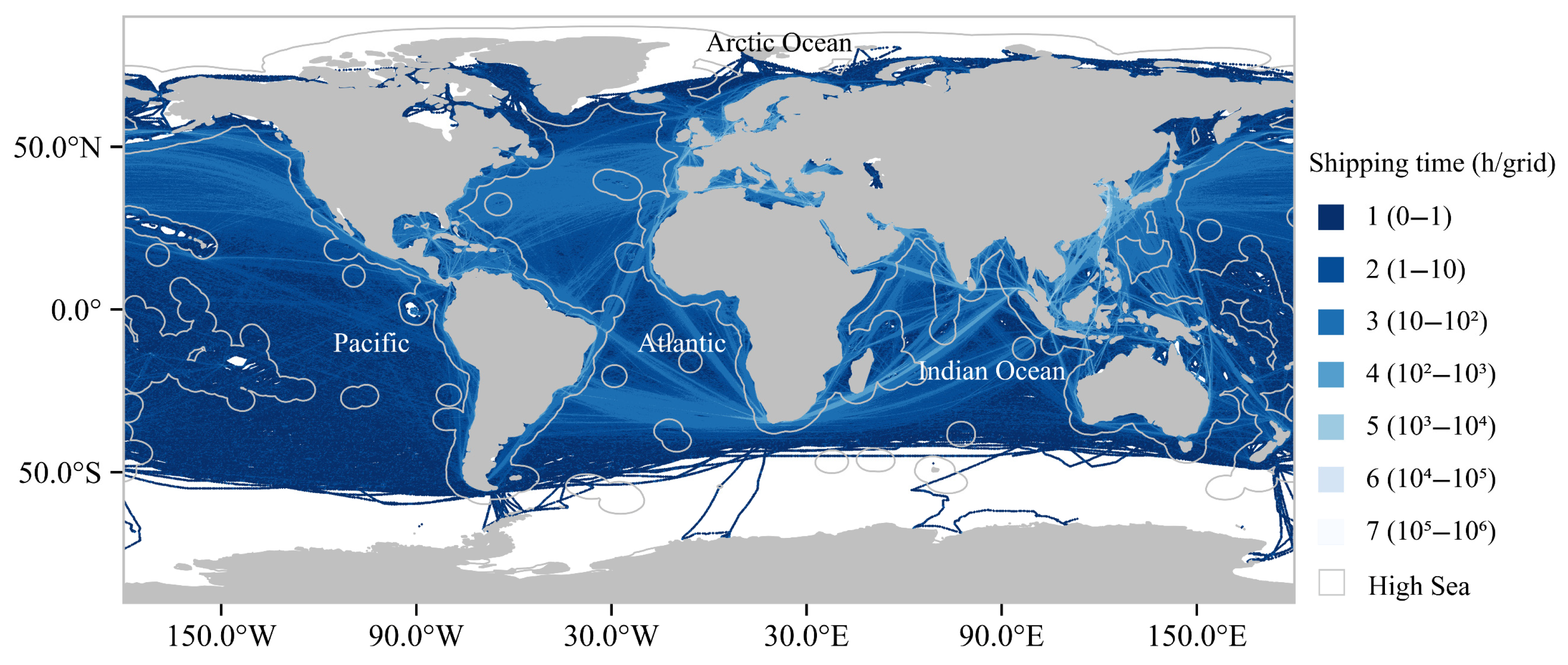
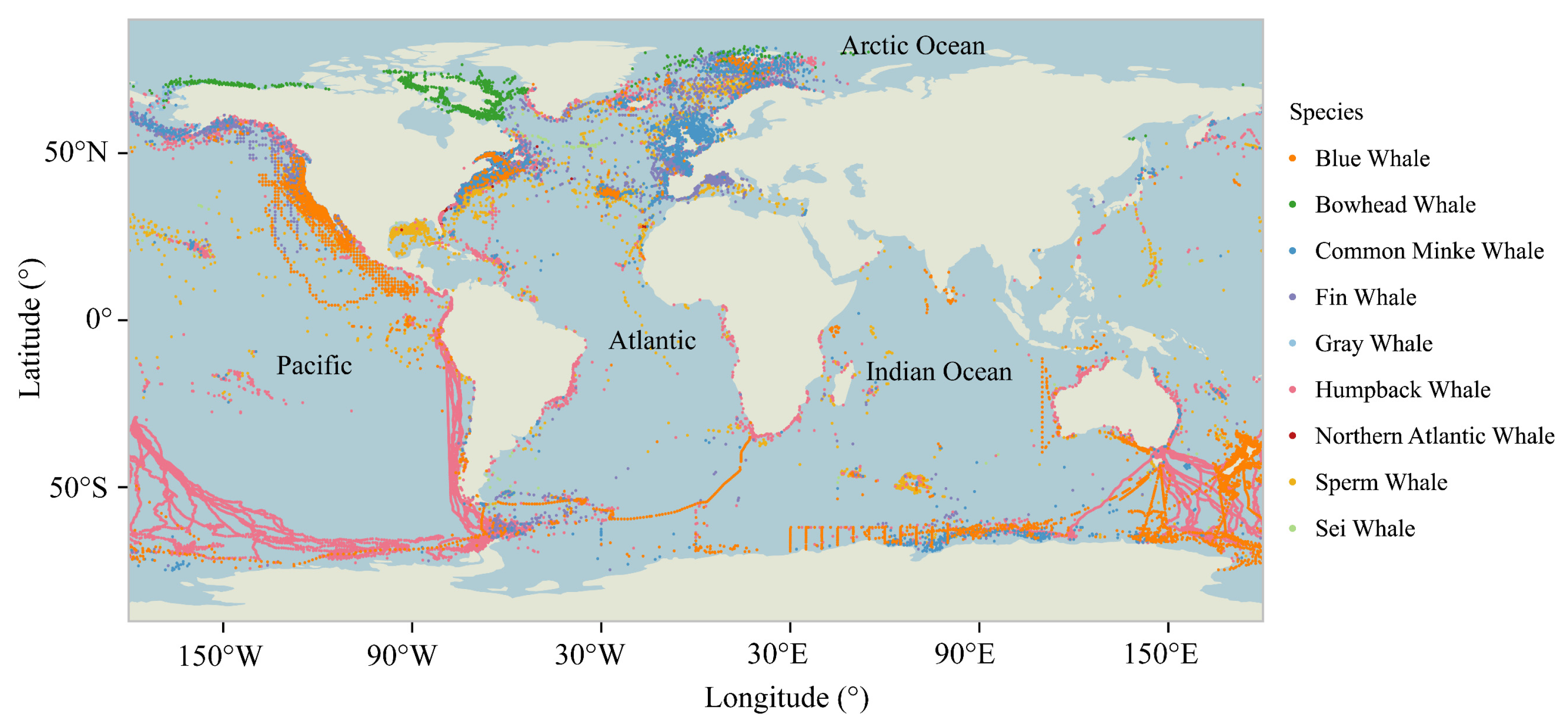
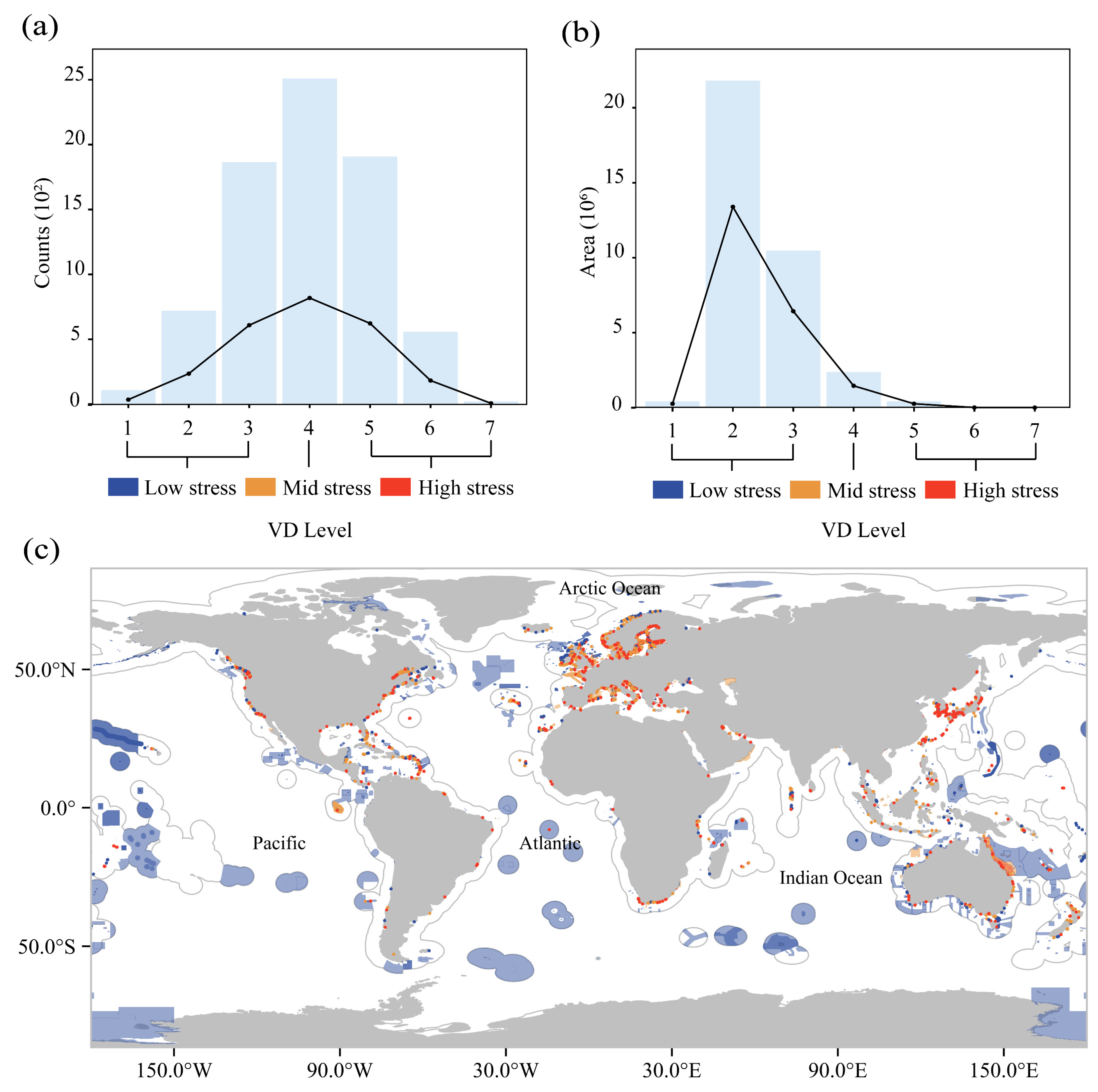
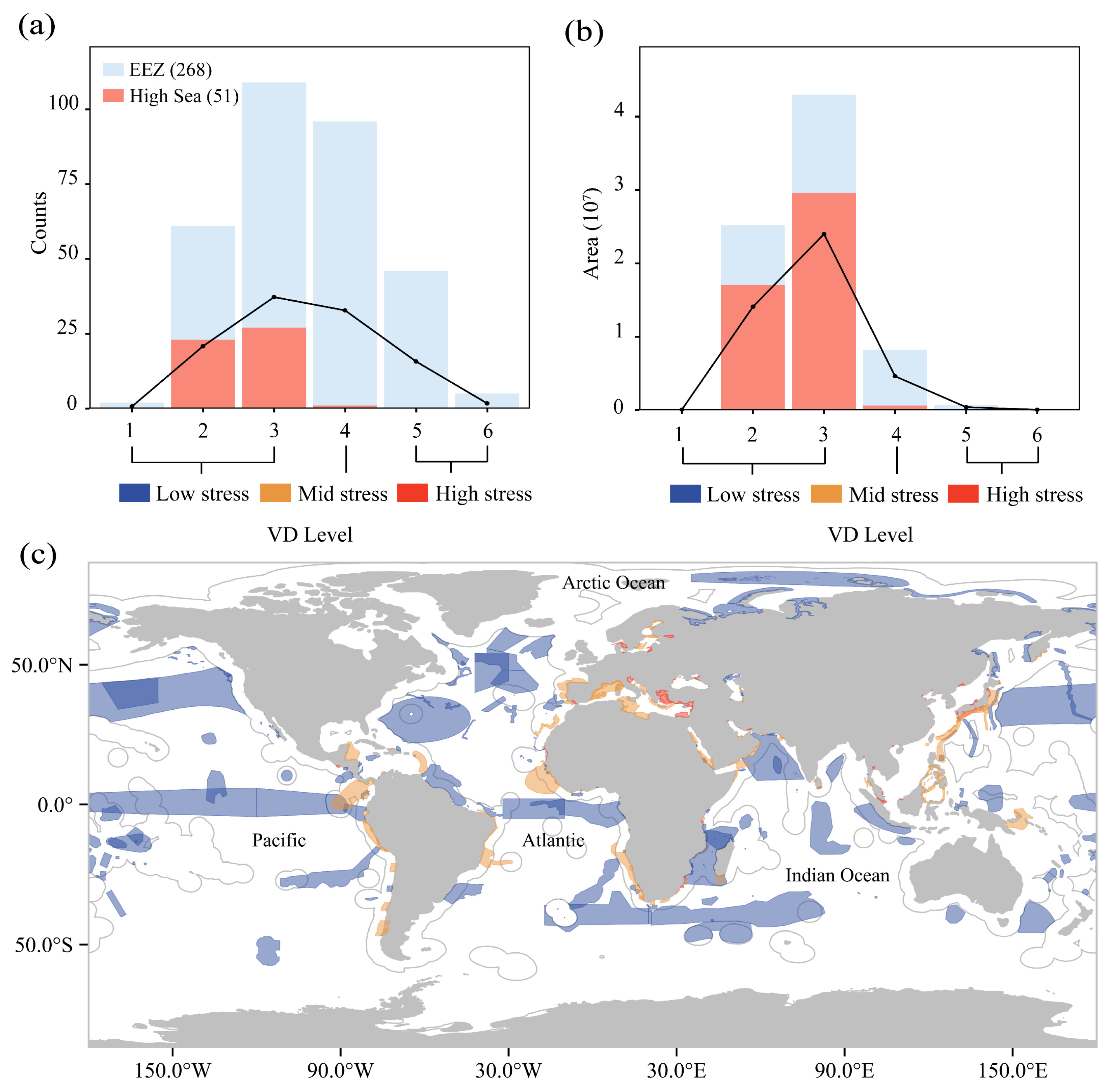
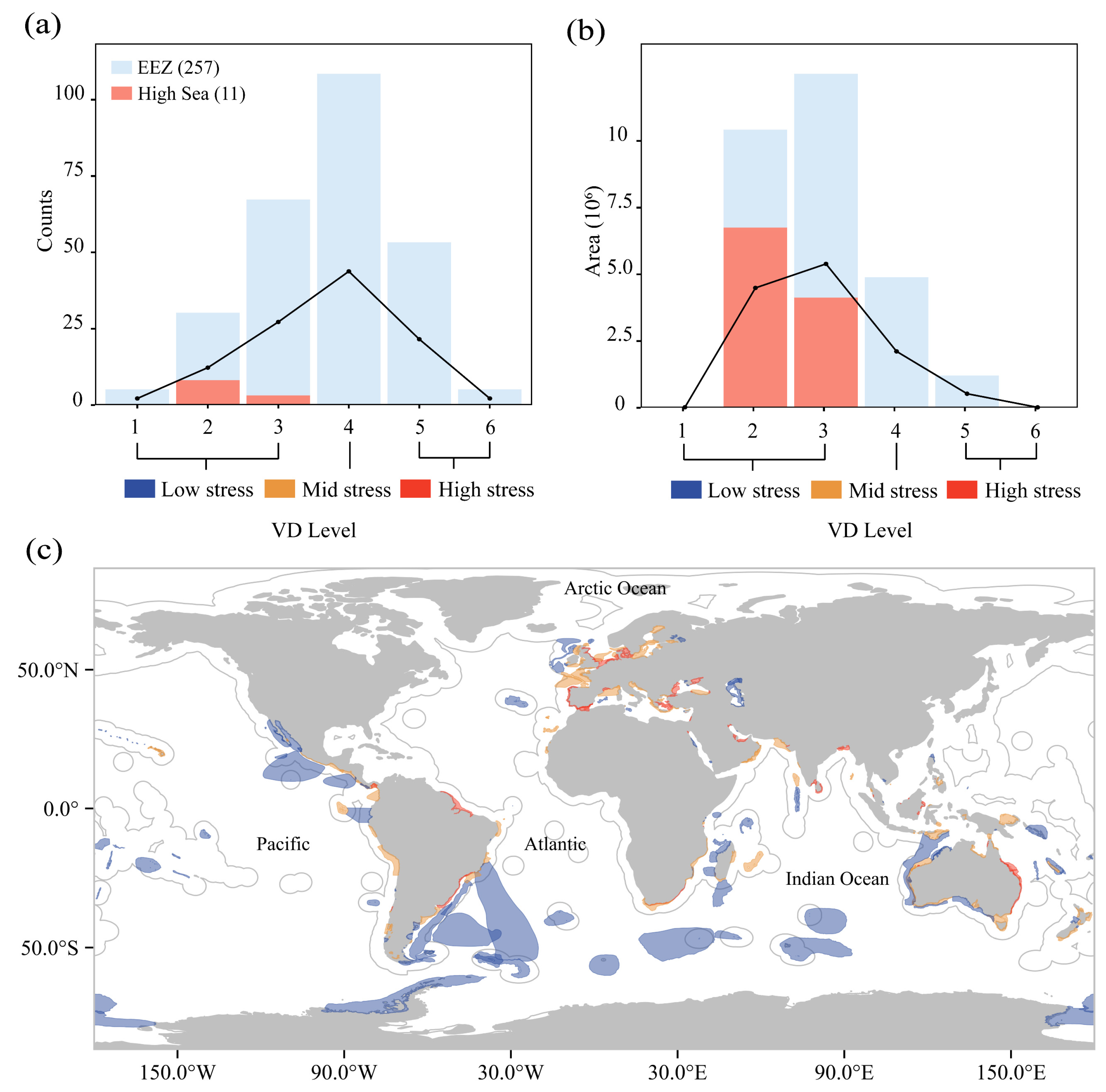
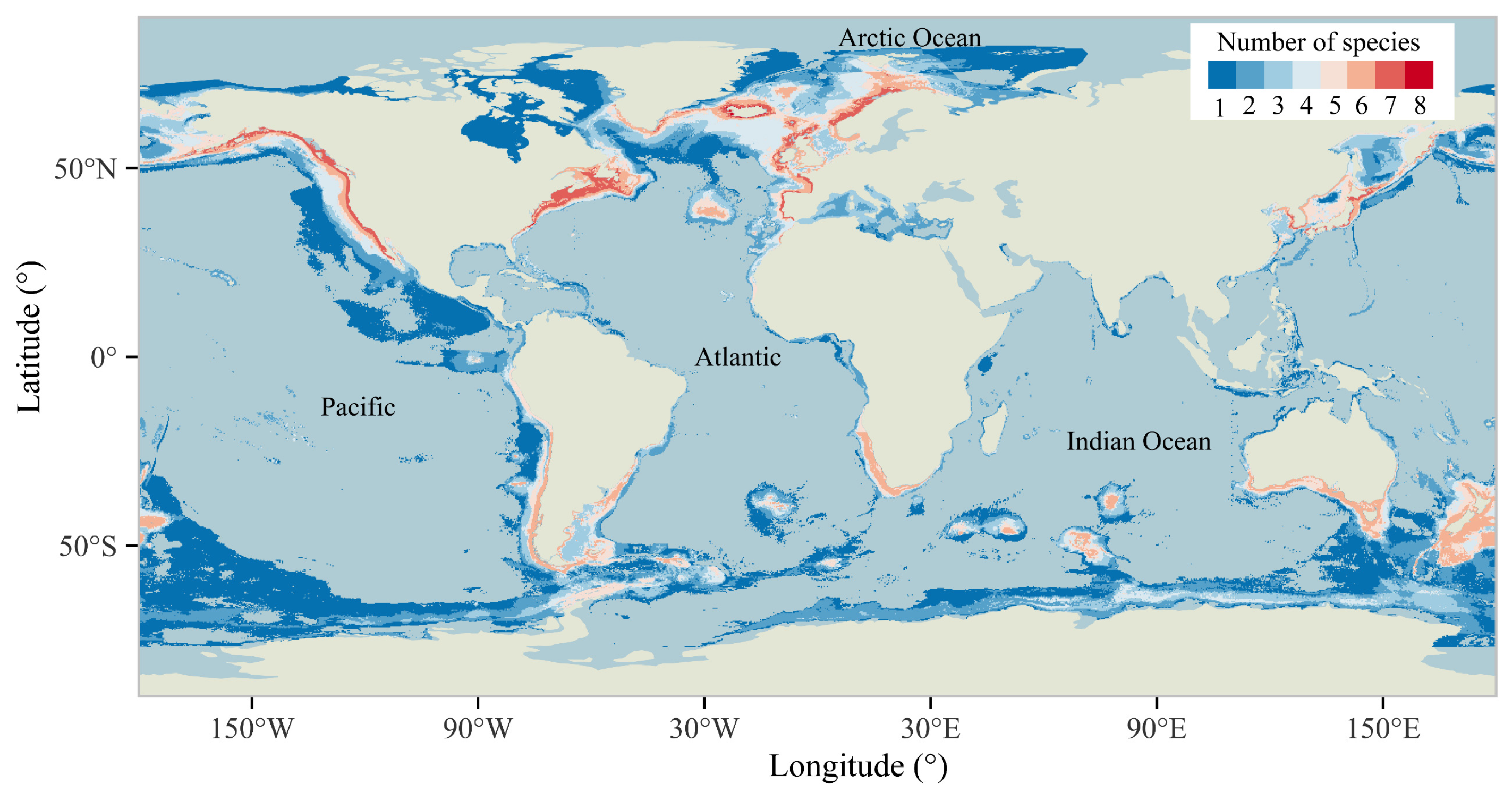

| Variable | Units | Spatial Resolution | Source |
|---|---|---|---|
| Sea Surface Temperature (SST) | °C | 0.25° | Cpernicus 1 |
| Salinity (Sal) | - | 0.25° | Cpernicus 1 |
| Chlorophyll (Chl) | mg/m3 | 0.25° | Cpernicus 1 |
| Mixed Layer Depth (MLD) | m | 0.25° | Cpernicus 1 |
| Sea Ice Thickness (SIT) | m | 0.25° | Cpernicus 1 |
| Sea Ice Cover (SIC) | m | 0.25° | Cpernicus 1 |
| Sea Surface Height (SSH) | Fraction | 0.25° | Cpernicus 1 |
| Bathymetry (Bat) | m | 0.05° | Bio-ORACLE 2 |
| Topographic Slope (TS) | - | 0.05° | Bio-ORACLE 2 |
| Topographic Aspect (TA) | - | 0.05° | Bio-ORACLE 2 |
| Land from Distance (LandD) | km | 0.08° | MARSPEC 3 |
Disclaimer/Publisher’s Note: The statements, opinions and data contained in all publications are solely those of the individual author(s) and contributor(s) and not of MDPI and/or the editor(s). MDPI and/or the editor(s) disclaim responsibility for any injury to people or property resulting from any ideas, methods, instructions or products referred to in the content. |
© 2025 by the authors. Licensee MDPI, Basel, Switzerland. This article is an open access article distributed under the terms and conditions of the Creative Commons Attribution (CC BY) license (https://creativecommons.org/licenses/by/4.0/).
Share and Cite
Wang, B.; Zhao, L.; Lu, T.; Li, L.; Li, T.; Cong, B.; Liu, S. Global Hotspots of Whale–Ship Collision Risk: A Multi-Species Framework Integrating Critical Habitat Zonation and Shipping Pressure for Conservation Prioritization. Animals 2025, 15, 2144. https://doi.org/10.3390/ani15142144
Wang B, Zhao L, Lu T, Li L, Li T, Cong B, Liu S. Global Hotspots of Whale–Ship Collision Risk: A Multi-Species Framework Integrating Critical Habitat Zonation and Shipping Pressure for Conservation Prioritization. Animals. 2025; 15(14):2144. https://doi.org/10.3390/ani15142144
Chicago/Turabian StyleWang, Bei, Linlin Zhao, Tong Lu, Linjie Li, Tingting Li, Bailin Cong, and Shenghao Liu. 2025. "Global Hotspots of Whale–Ship Collision Risk: A Multi-Species Framework Integrating Critical Habitat Zonation and Shipping Pressure for Conservation Prioritization" Animals 15, no. 14: 2144. https://doi.org/10.3390/ani15142144
APA StyleWang, B., Zhao, L., Lu, T., Li, L., Li, T., Cong, B., & Liu, S. (2025). Global Hotspots of Whale–Ship Collision Risk: A Multi-Species Framework Integrating Critical Habitat Zonation and Shipping Pressure for Conservation Prioritization. Animals, 15(14), 2144. https://doi.org/10.3390/ani15142144





